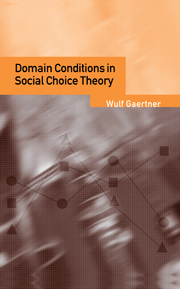Book contents
- Frontmatter
- Contents
- Preface and acknowledgements
- 1 Introduction
- 2 Notation, definitions and two fundamental theorems
- 3 The existence of collective choice rules under exclusion conditions for finite sets of discrete alternatives
- 4 Arrovian social welfare functions, nonmanipulable voting procedures and stable group decision functions
- 5 Restrictions on the distribution of individuals' preferences
- 6 The existence of social choice rules in n-dimensional continuous space
- 7 Concluding remarks
- References
- Author index
- Subject index
5 - Restrictions on the distribution of individuals' preferences
Published online by Cambridge University Press: 02 December 2009
- Frontmatter
- Contents
- Preface and acknowledgements
- 1 Introduction
- 2 Notation, definitions and two fundamental theorems
- 3 The existence of collective choice rules under exclusion conditions for finite sets of discrete alternatives
- 4 Arrovian social welfare functions, nonmanipulable voting procedures and stable group decision functions
- 5 Restrictions on the distribution of individuals' preferences
- 6 The existence of social choice rules in n-dimensional continuous space
- 7 Concluding remarks
- References
- Author index
- Subject index
Summary
A common feature of the restrictions on individual preference relations presented in chapter 3 was that certain individual preferences were not allowed to occur at all (as in the case of Inada's dichotomous preferences) or were excluded in the presence of other preference relations (as, for example, in the case of Sen and Pattanaik's extremal restriction). The approach that we shall follow in the present section is to admit all logically possible individual orderings but to look for conditions on the distribution of voters' preferences such that a consistent (transitive, quasitransitive or acyclic) majority decision is guaranteed.
The majority decision rule
Conditions on the distribution of preferences in the original profile
Definition. For any triple of alternatives x,y,z: (i) x is strictly best (semi-strictly best) in the aggregate sense (i.e. collectively) if xPy and xPz (either xPy ∧ xRz ∨ xRy ∧ xPz); (ii) x is strictly worst (semi-strictly worst) in the aggregate sense if yPx and zPx (either yPx ∧ zRx ∨ yRx ∧ zPx); (iii) there is total indifference in the aggregate sense over the triple if xIy, yIz, and xIz.
Definition. The Extended Condorcet Condition (ECC) is satisfied iff for every triple of alternatives (x,y,z) there is at least one issue which is strictly best or strictly worst in the aggregate sense, or the triple of alternatives is totally indifferent in the aggregate sense.
- Type
- Chapter
- Information
- Domain Conditions in Social Choice Theory , pp. 76 - 98Publisher: Cambridge University PressPrint publication year: 2001



